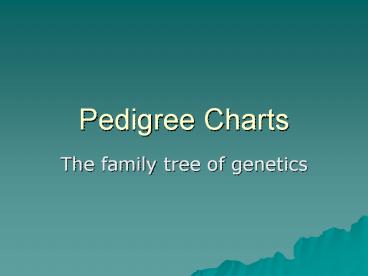Pedigree Charts - PowerPoint PPT Presentation
1 / 40
Title:
Pedigree Charts
Description:
Pedigree Charts The family tree of genetics 4. Transgenic Organism: trans = across genic = race Contains genes from another organism Bacteria Virus Human 5. – PowerPoint PPT presentation
Number of Views:217
Avg rating:3.0/5.0
Title: Pedigree Charts
1
Pedigree Charts
- The family tree of genetics
2
Pedigree Charts
I
II
III
3
Overview
- What is a pedigree?
- Definition
- Uses
- Constructing a pedigree
- Symbols
- Connecting the symbols
- Interpreting a pedigree
4
What is a Pedigree?
- A pedigree is a chart of the genetic history of
family over several generations. - Scientists or a genetic counselor would find out
about your family history and make this chart to
analyze.
5
Constructing a Pedigree
- Female
- Male
6
Connecting Pedigree Symbols
Examples of connected symbols
- Fraternal twins
- Identical twins
7
Connecting Pedigree Symbols
Examples of connected symbols
- Married Couple
- Siblings
8
Example
- What does a pedigree chart look like?
9
Symbols in a Pedigree Chart
- Affected
- X-linked
- Autosomal carrier
- Deceased
10
Interpreting a Pedigree Chart
- Determine if the pedigree chart shows an
autosomal or X-linked disease. - If most of the males in the pedigree are affected
the disorder is X-linked - If it is a 50/50 ratio between men and women the
disorder is autosomal.
11
Example of Pedigree Charts
- Is it Autosomal or X-linked?
12
Answer
- Autosomal
13
Interpreting a Pedigree Chart
- Determine whether the disorder is dominant or
recessive. - If the disorder is dominant, one of the parents
must have the disorder. - If the disorder is recessive, neither parent has
to have the disorder because they can be
heterozygous.
14
Example of Pedigree Charts
- Dominant or Recessive?
15
Answer
- Dominant
16
Example of Pedigree Charts
- Dominant or Recessive?
17
Answer
- Recessive
18
Summary
- Pedigrees are family trees that explain your
genetic history. - Pedigrees are used to find out the probability of
a child having a disorder in a particular family. - To begin to interpret a pedigree, determine if
the disease or condition is autosomal or X-linked
and dominant or recessive.
19
Pedigree Chart -Cystic Fibrosis
20
Human Genetics
21
Karyotype
22
Chromosome Number
Homologous Chromosomes are the sets of each pair
- Different for different species
- Full set 2NDiploid
- N
- pairs
- 1 pair from mother
- 1 pair from father
- Humans 23 pairs or
- 46 total
23
Autosomes Sex Chromosomes
Autosomes 1-22 for all traits except sex
Sex chromosomes Pair 23 XX(female)
or XY(male)
24
Down Syndrome 3 of 21
25
Klinefelters XXY
26
Multiple Alleles
- More than one type of allele for a trait
- Example
- Blood Type
- TYPES
- A IAIA, IAi
- B IBIB , IBi
- AB IAIB
- O ii
27
Mutation
A to A G C
A T GC
- Change in DNA code
- Caused by
- Chemical damage
- Errors in Replication
- X-ray damage
- UV damage
X
28
Mutation
- Changes in the DNA code
- Changes in the final proteins made
- Changes in the organism
29
Genetic Technology
- Recombinant DNA
- Bacterial Transformation
30
1. Transgenic tobacco plant?
- Genetically engineered
- Inserting fire fly genes into the plant
- Using cut paste enzymes
31
2. Genetic Engineering
- Altering the genetic makeup of an organism
- By Cutting DNA from one organism and inserting
fragments into a host - Recombinant DNA
- Alters the allele frequency of a population by
artificial means
32
Recombinant DNA
- Recombine
- Connecting or reconnecting DNA fragments
- DNA of two different organisms
- Example lab of inserting human DNA into bacteria
33
Genetic Engineering of Insulin
Human DNA cut out
Human DNA put into bacteria DNA
Many Bacteria Grow human insulin
Bacteria DNA is opened up
34
4. Transgenic Organism
- trans across
- genic race
- Contains genes from another organism
- Bacteria
- Virus
- Human
35
5. Tobacco Recombinant DNA Process
- Isolated DNA to be inserted into host
- Attach DNA fragment to a vehicle (vector)
- Transfer the vector to the host
- Transgenic organisms
36
Restriction Enzymes
Bacterium DNA cut
Human Cut
Restriction Enzymes cut DNA at very specific
sites Separate the base pairs of both
strands Scissors in Recombinant DNA
37
7. Sticky ends
- DNA cuts that have single stranded ends
- Attract corresponding base pairs
- Made by special restriction (cutting) enzymes
GGCCATTAC CCGC
TACCGG TAATGATGGC
Stick together
38
Vectors vehicles
- Carry foreign DNA fragments into the host
- Bacteria carried the firefly DNA into the tobacco
cells - Biological or
- Mechanical
39
Vectors
- Biological
- Virus
- Bacterial plasmid (circular DNA)
- Mechanical
- Micropipette
- Metal bullet coated with DNA
40
Recombinant DNA Uses
- Grow human hormones in bacteria cultures
- Artificial sweeteners using bacteria to make
amino acids - Study human diseases by inserting human DNA into
mice - Replace incorrect DNA sequences
- Replace harmful bacteria on plants
- Nitrogen bacteria in the soil plants to make
fertilizer - Improve transport of fruits
- Resist diseases
- Increase protein production































